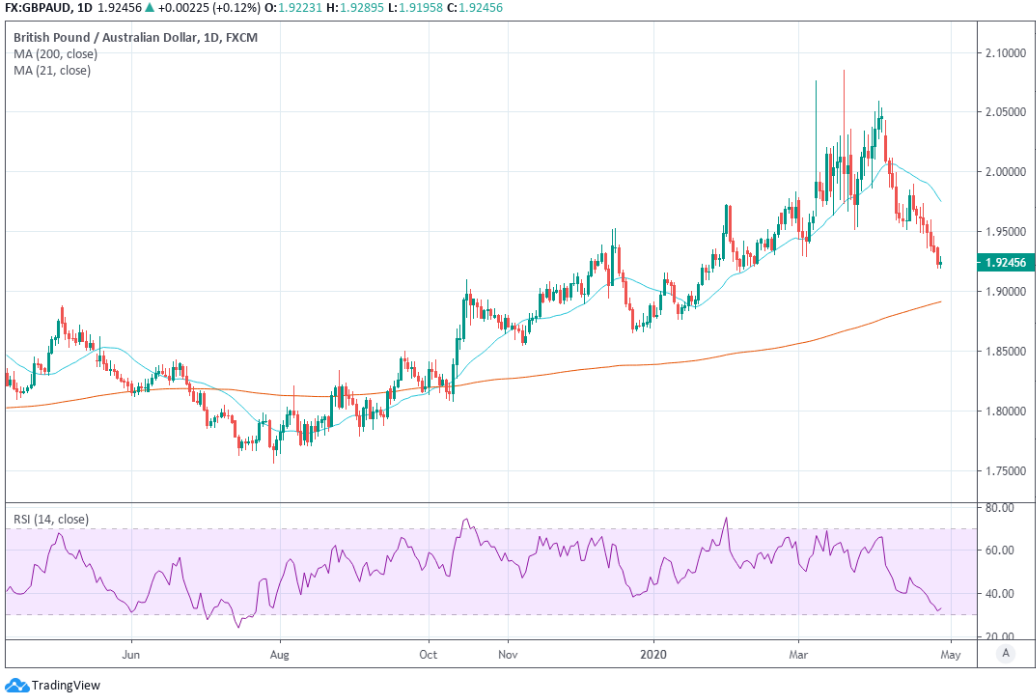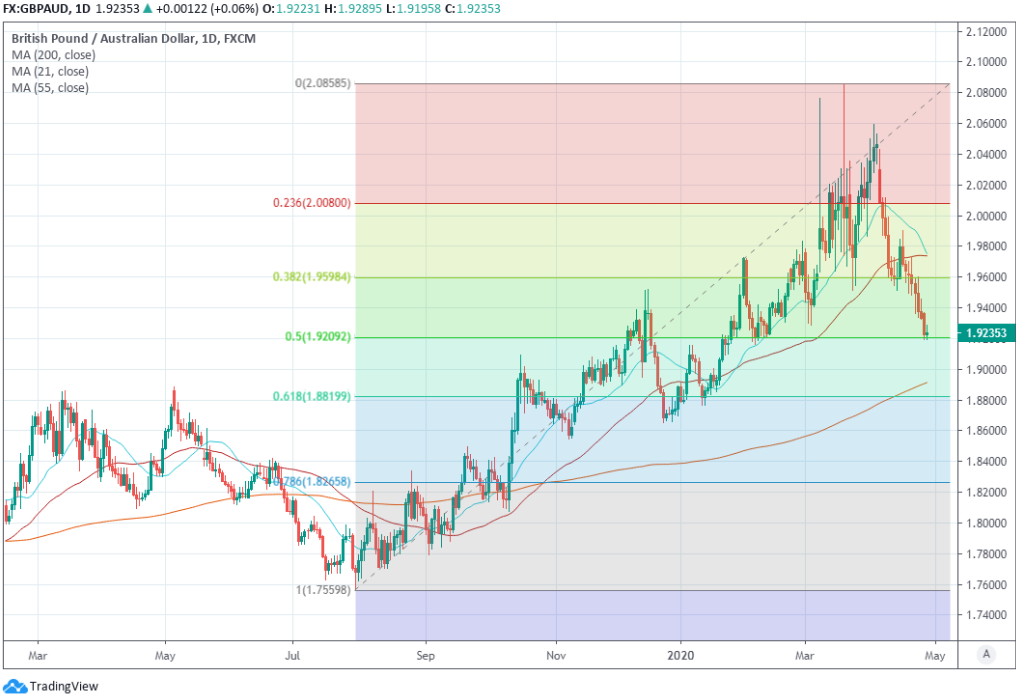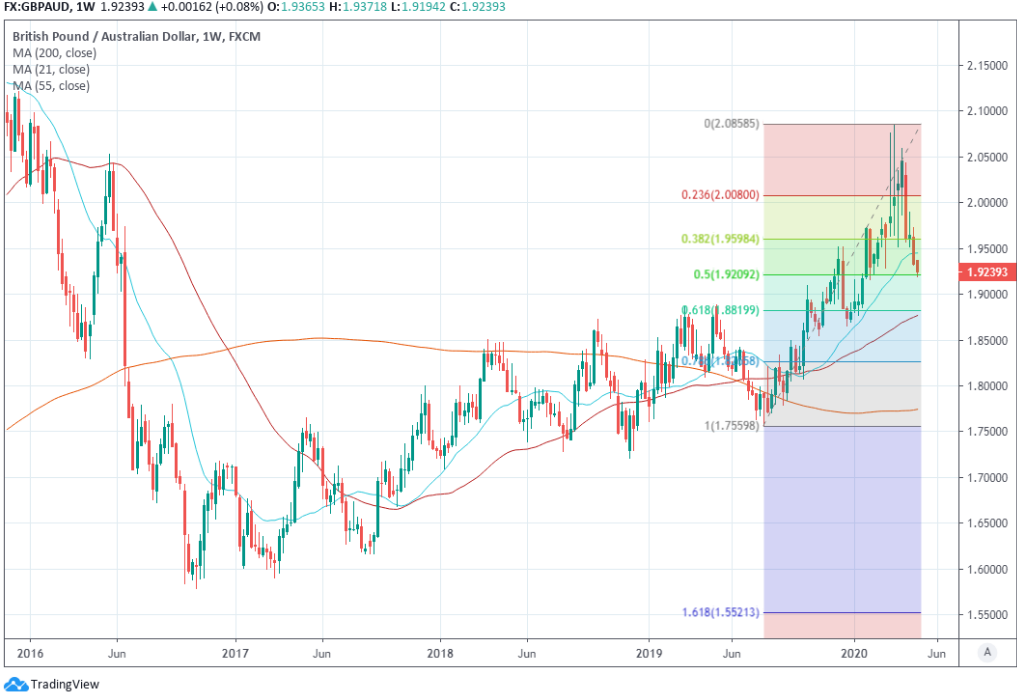Pound-Australian Dollar Rate View: October 2019 Lows Beckon as Brexit, Lockdown Concerns to Weigh
- Written by: James Skinner
-
- GBP/AUD is mean-reverting as fundamental headwinds build.
- Left clutching for support near 1.9209 Fibonacci level Tuesday.
- Brexit risks, UK's slow-coach lockdown exit to weigh on GBP.
- October 2019 lows beckoning, with lower levels also possible.
© Taras Vyshnya, Adobe Stock
- GBP/AUD spot at time of writing: 1.9229
- Bank transfer rates (indicative): 1.8560-1.8694
- FX specialist rates (indicative): 1.8945-1.9060 >> More information
The Pound-Australian Dollar rate was edging lower toward a key technical support level on the charts Tuesday and may attempt to stabilise over the coming days, although the fundamental headwinds are building for Sterling and October 2019 lows could now be beckoning.
The Pound-Australian Dollar rate has been pulled some -6% lower this April with the antipodean unit having been bolstered by a tentative improvement in investor risk appetite, a trend that could continue for as long as the mood in the market remains cheerful, although the exchange rate was being offered support by the nearby 1.92 level on Tuesday. This coincides closely with the 50% Fibonacci retracement of the summer 2019 extension higher.
However, as the British currency enters the new month, the gravitational pull of lower levels could become stronger in both risk-on and risk-off trading conditions. ‘No deal’ Brexit concerns could renew in the absence of a move toward an extension of the Brexit transition period by the government and a slower exit from ‘lockdown’ for the UK relative to many of the other major economies could both weigh on Sterling.
Albeit from the perspective of a non-expert, the outlook appears decidedly bearish from a technical perspective too. Sterling now appears to be mean-reverting against the Australian Dollar and on course for at least the 200-day moving average at 1.8911, implying nearly -2% downside from the current market. This is after a strong uptrend that saw the exchange rate repeatedly risk becoming ‘overbought’ in the first quarter.
After a sustained outperformance of the Aussie into early April the Pound set a fresh post-referendum high of 2.0862 but this was accompanied by further bearish divergence between the exchange rate and the relative-strength-index on the charts, where the latter failed to set a new high concurrently. This loss of momentum began in late March and preceded the correction lower that played out ahead of month-end.
Above: Pound-Australian Dollar rate shown at daily intervals with relative-strength-index displayed in lower pain.
“A divergence takes place when price and the oscillator move in opposite directions. A bearish divergence takes place when prices move to new highs, while the indicator fails to confirm and turns lower,” says George Davis, chief technical strategist at RBC Capital Markets, in a brochure explaining key concepts to clients. “Divergences serve as a warning sign as they often coincide with or precede a change in trend.”
Since this bearish divergence first appeared on the charts Sterling has found itself in all-out retreat from the Australian Dollar and has this month clocked up daily closes below both the 21 and 55-day moving averages. The next levels down are the 50% Fibonacci retracement at 1.9209, reached on Tuesday, and the 200-day moving average at 1.8911.
A bullish risk-on scenario where the GBP/USD rate trades above the 21-day moving average and to its accelerated downtrend around 1.2440, while the AUD/USD rate extends its rally to 0.65 after closing above the 55-day moving average Thursday and Friday, would produce a Pound-Australian Dollar rate of 1.9138 and something like the above outcome. The GBP/AUD rate always closely matches the sum of GBP/USD over AUD/USD.
"AUD/USD’s bounce off the recent lows at .6265/55 has the current April high at .6445 in its sights. It is expected to be exceeded while the .6265/55 support area underpins," says Axel Rudolph, a senior technical analyst at Commerzbank. "Above .6451 would allow for a test of the .6684/96 March high."
Sterling-Dollar-bloc rates can move quickly and this kind of price action could play out within days. What’s more, it’s achievable in both risk-on as well as a risk-off scenarios. The market's distinction between Sterling and riskier commodity currencies appears to have lessened since coronavirus compelled the government to dig deep into stretched and worn pockets, prompting concerns in some parts about the equilibriums that might be required in light of the ‘achilles’ heel’ current account deficit and rising budget deficit.
Above: GBP/AUD rate at daily intervals with Fibonacci retracements of 2019 uptrend and some key moving-averages.
Furthermore, the UK government has until June 30 to request an extension of the Brexit transition but has said it won’t and that if the EU asks for an extension of the talks it will say no. The government also acknowledged on Friday that it has made only “limited progress” in negotiations on the future relationship with barely nine more weeks to go until the cut-off date to request an extension of the December 31 deadline. This risks reviving something like the ‘no deal’ Brexit ‘cliff edge’ and associated ‘risk premium’ that dogged the British currency last year and on many other occasions since the 2016 referendum.
In addition, and after having been among the last major economies to get the coronavirus the UK now looks like it might also be last to exit the draconian lockdown that's been used to slow the spread. Prime Minister Boris Johnson is expected to set out plans this week for lifting the restrictions although it's not clear when they'll take effect from and it's also possible that a lack of personal-protective-equipment might slow the normalisation. This risks leaving the country, economy and currency sticking out like a sore thumb to investors.
This is the fundamental backdrop for the mean-reverting Pound-Australian Dollar rate. Ultimately, there's no telling what being a sore thumb will mean for Sterling in a coronavirus-plastered world and the last time ‘no deal’ Brexit concerns really and truly asserted themselves on the Pound-Australian Dollar rate in July 2019, it spent three weeks trading 150 points odd either side of 1.7750. That’s nearly 8% below the current market and although probably unlikely to be seen again in the short-term, it probably also can’t be ruled out for June. This scenario would require an AUD/USD rate of 0.65 and a GBP/USD rate of 1.15 that might be a bridge too far in the short-term.
A more likely scenario might be a GBP/USD rate near 1.18 and an AUD/USD rate of 0.65, which would produce a Pound-Australian Dollar rate of 1.8153 that will have extended some way below its 200-day moving-average of prices, although this could potentially take a few weeks to playout.
Above: GBP/USD rate shown at daily intervals alongside AUD/USD.
"The April 22 inside day to the upside is short-term bullish for GBP/USD which is expected to be heading back up towards the late March high and 55 day moving average at 1.2486/1.2532 while this week’s low at 1.2247 underpins. Failure there would push the current April low at 1.2163 to the fore," Rudolph says.
Commerzbank's Rudolp is looking for a GBP/USD rate peak of 1.2532 in the short-term and an AUD/USD rate of something like 0.6684, which implies a Pound-Australian Dollar rate of 1.8749 that will have taken out the the 200-day moving-average at 1.8911. The Pound-Australian Dollar rate may find support on the 200-day average but it’s unlikely to be content to simply just visit it. For a Brexit and lockdown-stricken Sterling to cease appreciating against the Aussie, which it might be likely to, it will have to trade back toward its recent averages and if it's to depreciate then it will need to fall below those averages.
The Pound should probably fare poorly in a beauty parade alongside the Australian Dollar, which would always appeal more to investors in a global recovery scenario. The Aussie enjoyed a current account surplus heading into the crisis, its government’s books were about balanced and government debt-to-gdp was comfortably under 50%. Meanwhile, Sterling was carrying the developed world’s most persistently intimidating current account deficit that was being nurtured by a budget deficit equal to nearly 2% of GDP, although that’s very likely to be found in the double-digits as a result of the coronavirus. The writing on the wall says debt-to-GDP of 80% before the crisis could now exceed 100% if the downturn persists or the recovery is slow.
However, if the public finance disparity isn't enough to keep the tide flowing against the Pound-Australian Dollar rate then the fact that some developed economies including Australia, New Zealand and many others in Europe are increasingly seeking to exit lockdown and return to something that vaguely resembles normality could be. This could burnish the appeal of the commodity-backed Aussie as Sterling begins to suffer from fresh Brexit headwinds and a possible slow-coach exit from its own ‘lockdown’.
Above: GBP/AUD rate at weekly intervals with Fibonacci retracements of 2019 uptrend and some key moving-averages.
What if all of this is wrong, what about the upside?
It doesn’t get above 2.0886, which means the top has more or less been seen at least until the Brexit question is closer to resolution. This would require an optimistic scenario and one that’s probably too generous to Sterling where the GBP/USD rate attains the 55-day moving average at 1.2532 while AUD/USD gives up all of its April gains and trades back down to 0.60.
It would probably take a severe global risk-off scenario or significant and unlikely Reserve Bank of Australia event to get the Aussie back down there and there’s no good reason for why Sterling should be able to hold those levels against the greenback in such circumstances.
The more likely GBP/USD outcome in that scenario might be somewhere between 1.20 and 1.22, which would put the Pound-Australian Dollar rate somewhere between 2.00 and 2.0333. However, this possible interim outcome would be as good as it gets for Britain-based buyers of the Australian Dollar.
Personally, this financial scribbler favours a GBP/USD rate of 1.20 alongside an AUD/USD rate of 0.65 no later than end-May, making for a Pound-Australian Dollar rate of 1.8461 that has traded some way below its 200-day moving-average at 1.8911 and close to its 61.8% Fibonacci retracement of the summer 2019 extension higher. In short, the British currency is found wanting in an beauty parade and has around -4% downside from Tuesday's 1.9229 over the next three weeks or so, suggesting dark days ahead for Sterling denominated Australian Dollar buyers.1.8270 is also a likelihood. These are October 2019 lows that beckon. Lower might also be found further down the line.














